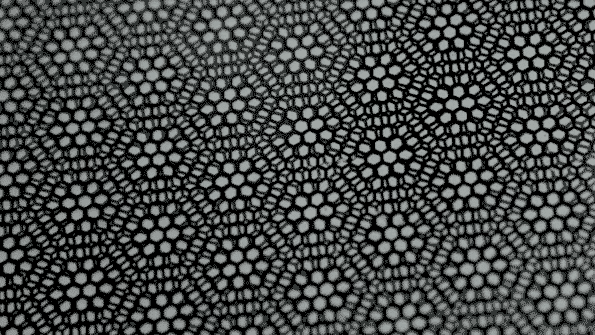
Speaking with Andrea Young feels like watching a racehorse holding itself back at the starting gate. We met on the campus of the University of California, Santa Barbara, where he’s a condensed matter physicist, to chat about his work on 2-D materials. His mind seems to be working faster than the conversation can flow. My sense is, once the reins are loosened — and he’s back in the lab — he’ll take off.
Young’s colleagues confirm that’s the case. “He’s a whirlwind,” says physicist Raymond Ashoori of MIT. When Young was a postdoc in his lab, Ashoori says, it felt like “an idea a minute.”
Young, 35, has a way with substances shaved to the thickness of a single atom, such as the sheets of carbon known as graphene. His research has revealed new states of matter, and advanced scientists’ understanding of the strange physics that arises when materials are sliced thin.
“Things change a lot when you change the number of dimensions,” Young says.
As a graduate student at Columbia University, Young helped create a new type of material that transformed how scientists study graphene. Along with physicists Cory Dean, Philip Kim and colleagues, Young devised a technique for layering graphene with other materials, in particular another compound that forms 2-D sheets called hexagonal boron nitride. The combination makes the sometimes-finicky graphene easier to work with. And the material’s electrons can be coaxed to behave in unusual ways, interacting strongly with one another, for example. Reported in Nature Nanotechnology in 2010, the technique was quickly adopted by scientists around the world. “Everybody uses it now,” Ashoori says.
After his time at Columbia, Young went on to stints at MIT and the Weizmann Institute of Science in Rehovot, Israel, before landing at UC Santa Barbara in 2015. So far, Young has used his layering technique to reveal new quantum phenomena and states of matter with tongue-twisting names like Hofstadter’s butterfly and fractional Chern insulators. In many of the materials Young studies, electrons exhibit collective behavior, resulting in quasiparticles, excitations in a material that mimic a real subatomic particle. It’s a bit like how a crowd of individual people can do the wave by working together.
Keeping up with Young’s rapid progress in the lab kept his graduate adviser, Kim, busy. “He’s extremely brilliant and very energetic,” says Kim, now at Harvard University. Young’s understanding of theoretical concepts, in combination with experimental know-how, makes him quick to generate and implement new ideas, or follow up on hot research topics. In 2018, he, Dean and colleagues were the first to replicate a blockbuster result in condensed matter physics: Two sheets of graphene, when layered and rotated with respect to one another, become superconducting, allowing electrons to flow without resistance. Young and colleagues added their own twist, reporting in the March 8 Science that the material’s superconductivity could be tuned by putting it under pressure.
 Layering 2-D materials like the ones Andrea Young studies can bring out new features. When two honeycomb-like layers of graphene are overlaid, a new pattern, known as a moiré pattern, appears. The layering can have big effects on the electrons within. At a certain angle the material becomes superconducting.Courtesy of Y. Cao et al
Layering 2-D materials like the ones Andrea Young studies can bring out new features. When two honeycomb-like layers of graphene are overlaid, a new pattern, known as a moiré pattern, appears. The layering can have big effects on the electrons within. At a certain angle the material becomes superconducting.Courtesy of Y. Cao et al
Young’s swiftness seems to take multiple forms — quickness of thought, experimental agility and even fleetness of foot. During a particularly frenzied time, Dean, who has collaborated with Young for years, was headed to the lab bright and early at around 7 a.m. When Dean looked up, “100 yards ahead of me was Andrea, rushing even faster to get to the lab.”
Young’s fascination with physics came on quickly, too: “From my earliest memories, I wanted to be a physicist, and it’s not clear where that idea got nucleated,” says Young, who grew up in Washington, D.C.
He doesn’t see himself as fast, though. Rather than aiming for quick developments, he says that he’s motivated by big-picture, long-term questions. His current passion is searching for a proposed new class of quasiparticles, called non-abelian anyons. “That’s become the thing that … I’m obsessed with,” he says.
Scientists have discovered a wide variety of quasiparticles, but anyons don’t fit into either of the two categories all other particles do. They aren’t fermions, familiar particles like electrons, protons and neutrons; nor are they bosons, which include force-carrying particles, such as photons, particles of light that transmit electromagnetic forces.
Anyons, which appear only in two dimensions, are misfits. And non-abelian anyons are stranger still. Theory suggests they can be “braided” with one another by swapping their locations in a material. That braiding could protect fragile quantum information from becoming corrupt, potentially allowing scientists to create quantum computers that can perform calculations no standard computer can.
But no one has definitively shown that non-abelian anyons exist and have the useful properties necessary for quantum computing. A new state of matter called a fractional Chern insulator, which Young and colleagues reported for the first time in 2018 in Science, could be a likely hiding place. Young — hunter of strange denizens of 2-D matter — is in pursuit.
Source: Physics - www.sciencenews.org



